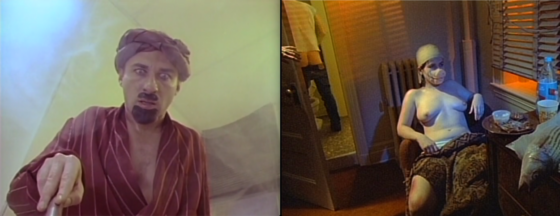Exploded View | Flaubert Dreams of Travel But the Illness of His Mother Prevents It

By Chuck Stephens
“Mosquitoes begin to hum, toads commence to leap; serpents hiss. Lightnings flicker. Hail falls. Then come gusts, bearing with them marvelous anatomies: Heads of alligators with hoofs of deer; owls with serpent tails; swine with tiger-muzzles; goats with the crupper of an ass; frogs hairy as bears; chameleons huge as hippopotami; calves with two heads, one bellowing, the other weeping; foetuses of quadruplets holding one another by the navel and spinning like tops; winged bellies flitting hither and thither like gnats.”—Gustave Flaubert, The Temptation of Saint Anthony
Undersung filmmaker Ken Kobland’s strange, sumptuous slice of classically minded surrealism, Flaubert Dreams of Travel But the Illness of His Mother Prevents It, created in 1986 in collaboration with The Wooster Group (America’s experimental-theatre ensemble extraordinaire) is, too, a creature born from Flaubert’s polymorphous bestiary. A multi-formed mirage, Flaubert Dreams of Travel (shot on video) evolved both to be seen in fragments on video monitors integrated into the shape-shifting set of Wooster Group’s Frank Dell’s The Temptation of St. Anthony—a melodramatic/madcap transfiguration of “Flaubert’s ‘closet drama’ about the visions and ecstasies of the fourth-century hermit St. Anthony” (per the Group)—and as a stand-alone, 20-minute riff on malaise, madness, and death in a seedy hotel room, scored to the cacophonous audio churn of a morning of children’s television circa 1963, and patently indebted to Un chien andalou (1929). As intoxicating as Ron Rice’s Chumlum (1964), perfumed with pallid flesh and rubber noses, and lazily propelled by an ongoing evanescence of opiated dissolves, Flaubert Dreams of Travel is an acid-laced sugar cube, easy to swallow and both a bit hilarious and a bit horrifying to digest, but impossible to forget. Have I mentioned that Willem Dafoe is one of its stars, appearing impressively full frontal? Or that you’ll get to see his dick poked with a stick?
A grower and a shower, Frank Dell (under the direction of WG visionary Elizabeth LeCompte, who shares credit in the creation of Flaubert Dreams of Travel with Kobland) was itself a wondrous phantasm, a spectacle that evolved in front of audiences during nearly a decade (1985-1994) of public rehearsals, ecstatically received performances, and often-autobiographical retoolings that incorporated the iconography of Dafoe’s role in The Last Temptation of Christ (and his Hollywood rise), and ultimately some of the final months in the life of its own star, the beloved and preternaturally talented Ron Vawter. Vawter was Frank Dell: a velvet-voiced St. Anthony, losing his marbles in a greasepaint moustache and goatee, cheap bathrobe, and bath-towel turban. He was named for Lenny Bruce’s alter-ego (a third-rate Vegas comedian), and he served as both the show’s emcee and the eye of an onstage maelstrom that swept up Flaubert’s phantasmic fever-play along with shards of Ingmar Bergman’s The Magician (1958), psychic Geraldine Cummins’ 1932 book The Road to Immortality (which Lenny Bruce had his secretary read to him not long before his death), and Albert Goldman’s Bruce biography (in which that piece of apocrypha appears). Such was the apogee of The Wooster Group’s deeply lysergic deconstructive vision: brilliant and feverish, ecstatically omnivorous and profoundly arcane…and now, alas, mostly consigned to misty memory, like one of Kobland’s luxuriously languid dissolves.
You can catch glimpses of Flaubert Dreams of Travel on The Wooster Group’s Vimeo page, rent it from Electronic Arts Intermix if you’re a programmer, or invest in Ken Kobland’s career-spanning, seven-disc box set (details at kenkoblandfilms.com), which collects Flaubert along with more than a dozen of the filmmaker’s internationalist and always-in-transit meditations on global politics, paranoid observation, and photographic poetry. All “dreams of travel,” the films’ titles assert the peripatetic capacities of Kobland’s vision: Moscow X (1994), Ideas of Order in Cinque Terre (2005), Berlin: Tourist Journal (1988)—there are worlds within. But Flaubert Dreams of Travel is something special: deep-dive surrealism that’s completely in tune with the globetrotting literary fantastications of the hotel-bound Raymond Roussel; a travelogue for a place that may never have actually existed; and a vestige of a world where never again can we go.
Chuck Stephens

